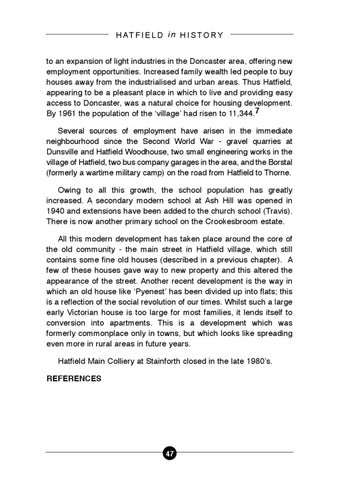H AT F I E L D i n H I S T O R Y to an expansion of light industries in the Doncaster area, offering new employment opportunities. Increased family wealth led people to buy houses away from the industrialised and urban areas. Thus Hatfield, appearing to be a pleasant place in which to live and providing easy access to Doncaster, was a natural choice for housing development. By 1961 the population of the ‘village’ had risen to 11,344.7 Several sources of employment have arisen in the immediate neighbourhood since the Second World War - gravel quarries at Dunsville and Hatfield Woodhouse, two small engineering works in the village of Hatfield, two bus company garages in the area, and the Borstal (formerly a wartime military camp) on the road from Hatfield to Thorne. Owing to all this growth, the school population has greatly increased. A secondary modern school at Ash Hill was opened in 1940 and extensions have been added to the church school (Travis). There is now another primary school on the Crookesbroom estate. All this modern development has taken place around the core of the old community - the main street in Hatfield village, which still contains some fine old houses (described in a previous chapter). A few of these houses gave way to new property and this altered the appearance of the street. Another recent development is the way in which an old house like ‘Pyenest’ has been divided up into flats; this is a reflection of the social revolution of our times. Whilst such a large early Victorian house is too large for most families, it lends itself to conversion into apartments. This is a development which was formerly commonplace only in towns, but which looks like spreading even more in rural areas in future years. Hatfield Main Colliery at Stainforth closed in the late 1980’s. REFERENCES
47
